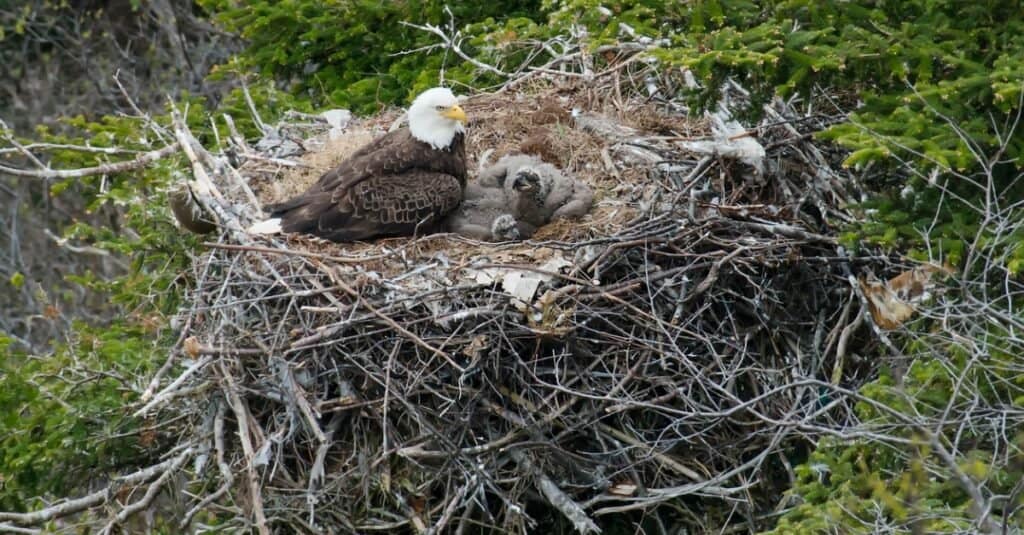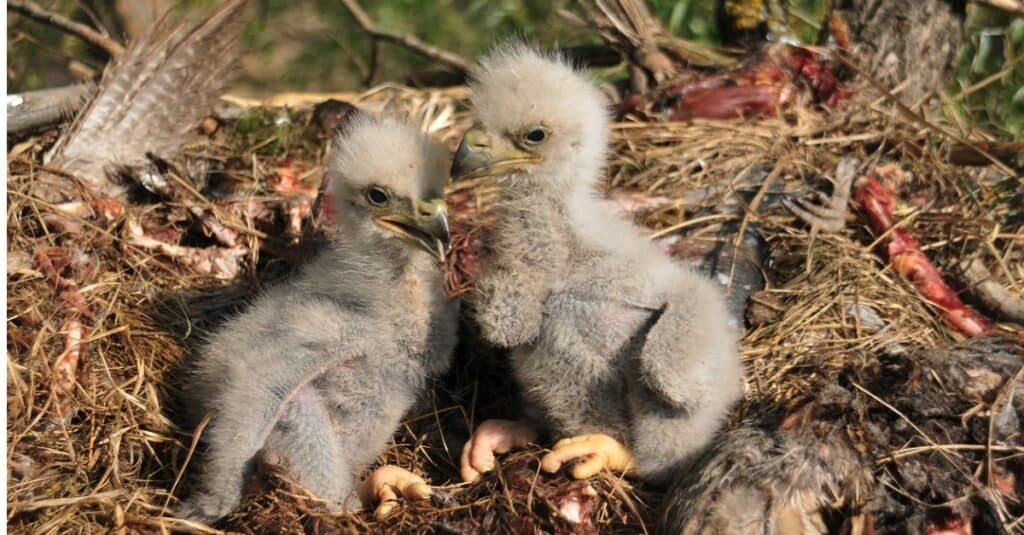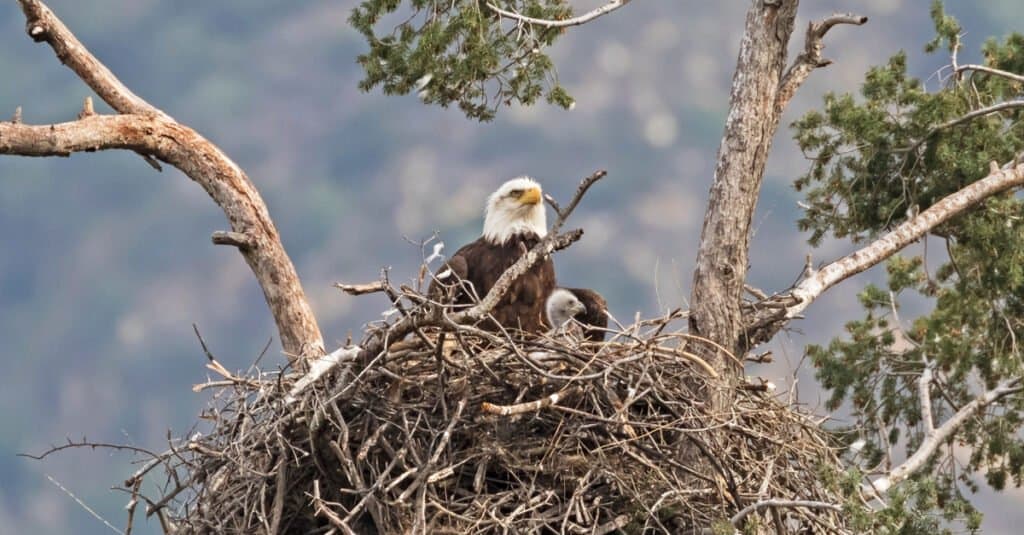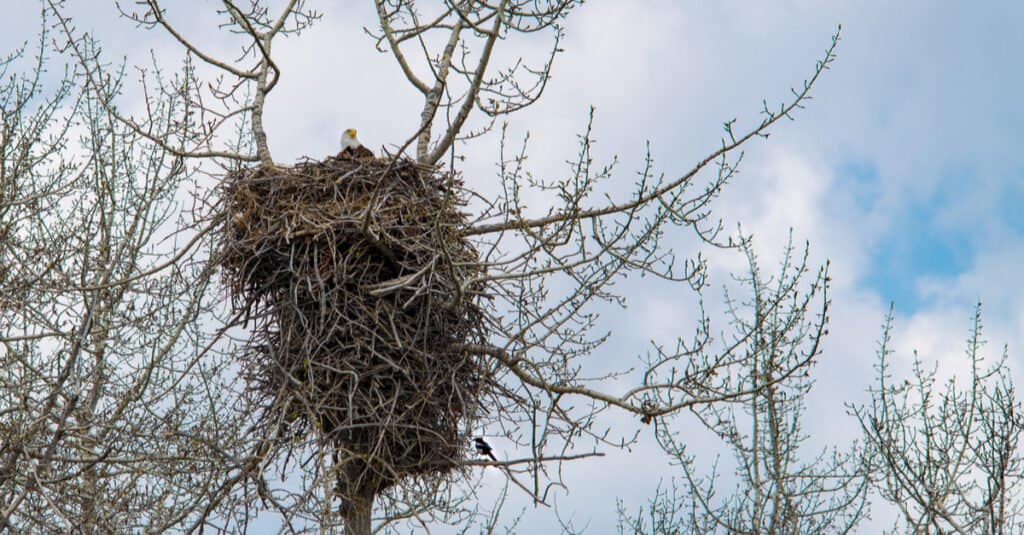The baby eagle is known for being a majestic and fiercely strong animal. There are a few things you may not know about baby eagles. Did you know a baby eagle’s nest can be huge? What about that their eyes are on the sides of their head rather than the front?
Read on to learn six amazing facts about the baby eagle.
#1: A Baby Eagle is Called an Eaglet!

Baby eagles are called eaglets!
©iStock.com/BrianEKushner
Did you know that a baby eagle is called an eaglet? Sometimes, eagle babies can also be called chicks or fledglings, depending on their age, but they aren’t the only birds called this! They share their name with many other species as well, such as robins, chickens, and even emus!
#2: Mother Eagles are Serious about Keeping their Babies Safe

Mother eagles work very hard to protect their babies from danger.
©iStock.com/PaulReevesPhotography
Did you know that female eagles take the safety of their young very seriously? It’s true! Baby eagles are born in a nest that is high above the ground. There are typically 2 but occasionally 3 eggs laid and hatching at once.
Before the mother eagle lays her eggs and sometimes even before mating, the pair of eagles that are soon to become parents start to acquire things that will help them build giant nests for their families. They use sticks, dried grass, feathers, and even occasionally trash as building materials.
An eagle’s nest is around four to five feet across. It is not uncommon for a pair of eagles to return to the same nesting spot to lay a new clutch of eagle eggs. Consequently, eagles will often build a new nest on top of the old one. This results in nests that can be as large as twenty feet!
#3: Eaglets are Called Fledglings While They Learn to Fly!

Eaglets stay with their mothers until they are ready to find their own flock.
©iStock.com/predrag1
Baby eagles, like most other birds, are not born knowing how to fly. In fact, they spend the first three months of their lives in the nest with their mothers, which is spent eating and gaining strength.
When a baby eagle begins the process of learning how to fly, it is called a fledgling. Even though this process begins around twelve weeks, eaglets still stay with their mothers until they’re around a year old. When an eaglet leaves its mother, it chooses the new flock it will spend the rest of its life with.
#4: Baby Eagles have Eyes on Either Side of their Heads

Eagles have a 340 degree range of vision.
©KGrif/Shutterstock.com
Unlike humans and many animals, baby eagles are born with their eyes on each side of their heads. This allows the babies to see in almost a panoramic view of 340 degrees rather than the 180 degrees we can see in. With eyes that are placed like an eagle’s, it’s no wonder they have no issue spotting food or keeping track of their future meals. Monocular and binocular vision is no issue for these amazing babies.
#5: Eagles have Incredible Eyesight

Eagles have extraordinary eyesight and can see some prey from over 2 miles away!
©Jon C. Beverly/Shutterstock.com
Humans can have up to 20/20 vision but eagles have 20/5 vision which means however well you may see something from five feet away, the eagle can see that well from over 20 feet away! An eagle that’s perched and hunting in the background can spot a rabbit from up to 2 and a half miles away. Another thing their eyes are capable of is seeing an amazing range of extremely vivid colors. This coupled with their incredible eyesight makes it nearly impossible to elude them.
#6: Baby Bald Eagles are Born Grey

Eaglets don’t get their distinct coloration for five years!
©Tom Clausen/Shutterstock.com
When most of us think of a bald eagle, we think about the distinct white heads and brown bodies. However, these babies are not born with this coloration.
When a bald eaglet has hatched it will be a light gray color for a few weeks. After that, they will go to brown all over their bodies. By the time a baby eagle gets its iconic brown and white feathers, it won’t even be a baby anymore. It can take up to five years for these feathers to come in completely! By that time, bald eagles may have a wingspan of more than six feet wide!
The photo featured at the top of this post is © iStock.com/predrag1
FAQs (Frequently Asked Questions)
What are baby eagles called?
A baby eagle is called an eaglet, chick, or even fledgling!
How much do baby eagles weigh?
Eaglets weigh only a few ounces upon hatching, it’s hard to be sure exactly how much because there is so little access to them especially at this age. It is known that they gain weight quickly and weigh just over a pound at 2 weeks old.
What do baby eagles eat?
When first born, baby eagles right away start eating the solid food their parents bring them. Typically the father will supply most of their first meals which consist of raw meat like fish and other small animals they can find since eagles are opportunistic eaters as adults. Being an opportunistic eater means they aren’t incredibly picky.
Where do baby eagles live?
Baby eagles are born in nests that have been prepared by their parents as a part of their mating and bonding process. They build their nest up high to keep their young safe. It’s said that they will build their nest up to 4 months before the female lays the eggs.
Thank you for reading! Have some feedback for us? Contact the AZ Animals editorial team.







